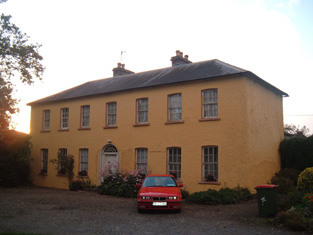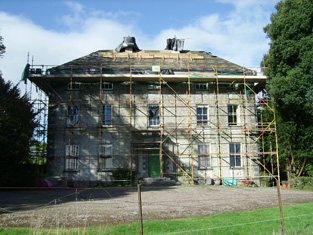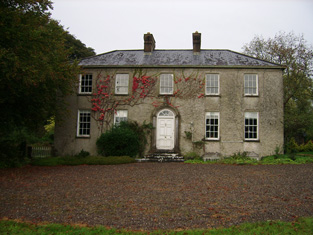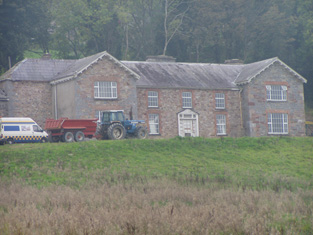Spitalfields
Houses within 5km of this house
Displaying 22 houses.
Houses within 5km of Spitalfields
Displaying 22 houses.
| House name | Description | |
|---|---|---|
| Dunbarry | This house was the home of James Carey in 1814. Occupied by James Heffernan and held from Sir Edward Tierney at the time of Griffith's Valuation, valued at £18. Sold by the Heffernans in the early 20th century, this house is still extant. The Irish Tourist Association survey mentions Dunbarry as the residence of Denis Kiely in the 1940s. | |
| Tullig | Tullig, located on the Tierney estate and valued at £15.15 shillings, was occupied by Richard Hutch in the early 1850s. The Irish Tourist Association Survey noted that it had belonged to Lord Broghill before the 1641 rebellion and was later granted to the Percevals. It was the residence of John Waterson in the 1940s. It is no longer occupied. |

|
| Burton Park | The original house built by Sir John Perceval and his descendants was burnt down in the Jacobite War 1689-1691. A late Georgian house was built to replace it by the [3rd or 4th] Earl of Egmont which was remodelled in the late 19th century. Burton Park was leased to the Purcells in the 19th century. It was occupied by the Reverend Matthew Purcell in 1814 and 1837 and by his son John in the early 1850s when the house was valued at £34. Passed to the Ryans of Scarteen, county Limerick by marriage in the early 20th century. In the 1940s the Irish Tourist Association Survey noted Burton Park as one of the best examples of eighteenth century domestic architecture in county Cork. Still the home of the Ryan Purcell family. |

|
| Walshestown | This townland was leased to Robert Conron early in the 18th century by Sir Philip Perceval. By 1814 the house was occupied by John Wrixon. Hajba writes that he was the son of Edward and Anne Wrixon. In the early 1850s Nicholas Wrixon was resident holding the house valued at £8 from John Wrixon. In the 1830s the house is recorded as being occupied by George Crofts and his wife Eliza Purcell of nearby Burton Park. George Crofts was a brother of the Reverend F.W. Crofts. This house is no longer occupied. |

|
| Jordanstown | A house valued at £14 was occupied at Jordanstown by James Buckley at the time of Griffith's Valuation and held from Sir Edward Tierney. Hajba writes that the Buckleys continued to live at Jordanstown for the rest of the 19th century. Sold to Patrick Walshe in the early 20th century this house is no longer occupied. |

|
| Liskelly | This house situated on the Egmont estate was occupied by Richard Gregg in 1814 and in the early 1850s by David Coghlan who held the house valued at £12 from Sir Edward Tierney. Later Liskelly became the residence of the Nagles and the Brownes. It is no longer occupied. | |
| Bregoge House | A house reputed to incorporate the remains of an old castle. Bregoge Castle was occupied by J. Rogers in 1837 and by John Rogers in the early 1850s. The property was held from the Earl of Egmont and the buildings were valued at £7. The Irish Tourist Association survey in the 1940s notes it as the residence of "Mr.Ryan, a commercial traveller". The house is still a family home. |

|
| Glenville | At the time of Griffith's Valuation Mary Allen occupied Glenvillle, a house valued then at £8. The property was held from the Earl of Egmont. Catherine Cooke daughter of William Allen of Glenville married John Bevan of Camas in 1856. Hajba writes that Glenville belonged to Massy Bevan in the late 19th century. The house was restored in the 20th century and is occupied. |

|
| Rathclare | Clare Cottage was originally a residence on the Egmont estate which Hajba writes was leased to the Norcott family. Occupied by Martha Bullen in the early 1850s when the house was valued at £13. A much larger house was constructed in the mid 19th century incorporating the original building. By the end of the 19th century the home of the Burdon family who were still resident in 2002. In 2012 it was being offered for sale. |

|
| Ardenville | A single storey house possibly built for the heir to the Egmont title, Baron Arden, to reside in before succeeding to the title. At the time of Griffith's Valuation it was occupied by James Norcott and valued at £11.10 shillings. Recently extended and still occupied. | |
| Egmont Cottage | Egmont Cottage is marked on the first Ordnance Survey map circa 1840. It was the single storied residence of Margaret Magrath in the early 1850s. She held the property from the Earl of Egmont and the buildings were valued at £10. The building has since been extended and is still occupied. Hajba calls this house Egmont Lodge. |

|
| Buttevant Castle | Originally a castle of the Barry family, Earls of Barrymore, sold by them in the early 19th century to John Anderson of Fermoy, who restored it as a castellated house and gave it to his eldest son Sir James Anderson. Sir James lived there until the mid 1840s. William Roche occupied the building valued at £37 in the early 1850s. He held the property from Viscount Doneraile and D.R. Browning held a house, flour mill and offices valued at £120 from Roche. The castle had various occupants in the later 19th century and was last occupied in the early 20th century. It is now a ruin. |

|
| Castle View | Located on the Doneraile estate in the mid 19th century this house was occupied by Barry Gregg in 1837 and by the Reverend Cornelius Burkley in the early 1850s when it was valued at £28. This 18th century seven bay house is still a family residence. |

|
| Springfield | The seat of the Norcott family in the 18th and 19th centuries, occupied by Hugh Norcott in 1814 and by James Norcott at the time of Griffith's Valuation when the buildings were valued at £18. The property was held from the Viscount Doneraile at this time. Sold to the Davisons in 1908, it remained in their possession for much of the 20th century. The house is still occupied. |

|
| Velvetstown | Seat of the Crofts family for over three centuries, "Velvex-town" was occupied by Thomas Crofts in 1814, by T. Lucas Crofts in 1837 and by Reverend William Crofts in the early 1850s. Reverend William held the house and 708 acres from Penrose Fitzgerald and the buildings were valued at £21. Hajba writes that the original house was replaced by an elaborate Italianate mansion in the late 1870s but when this burnt down in 1895 they moved back into their old home. She also writes that Velvetstown is one of the few North Cork houses still occupied by the family that built it. The Irish Tourist Association survey noted in the 1940s that the walls of the Italianate mansion were still standing though the chimneys had been taken down. |

|
| Currymount | Lewis gives J. O'Leary as the proprietor of Currymount in 1837. By the time of Griffith's Valuation Currymount was held by Alexander McCarthy in fee and was valued at £7.10 shillings. Hajba writes that Alexander McCarthy left Currymount to his brother-in-law, James Morrogh, third son of James Morrogh of the city of Cork. The house was considerably extended post Griffith's Valuation. James McCarthy of Currymount owned 259 acres in the 1870s. In the late 19th century Eustace Morrogh Bernard lived at Curraghmore. Bought by the Purcells of Burton Park in the second decade of the 20th century as a dower house and passed by marriage to the Bird family. The Irish Tourist Association Survey refers to it as the seat of Major Bird in the 1940s and also that the Morrogh-Bernard family resided here before going to live at Byblox. |

|
| Clogheen | In his journal William Lysaght refers to building a cottage at Clogheen in 1749. He was leasing Clogheen from Lady Midleton [see De Breffny, page 115]. By 1814 Clogheen was occupied by Arundel Hill who was still resident in 1837. Reverend William F. Crofts was the occupier at the time of Griffith's Valuation. He held the property from William Lysaght. It was valued at £31. In 1870 the house was occupied by Mrs Ellen Crofts. This house no longer exists although the outbuildings still stand. | |
| Ballyvonare | A Barry property from the late 18th century passing through the female line to the Harold/Harold-Barry family. The house was valued at £34 at the time of Griffith's Valuation and was held in fee. In the 1940s the Irish Tourist Association Survey outlined details of the family's history in the area and the existence of a soup kitchen there during the Famine. The Harold-Barrys still live at Ballyvonare. |

|
| Ballyellis | Ballyellis was occupied by Edmund Barry in 1814 and by Henry Langley at the time of Griffith's Valuation. H. Langley held the property from James Barry and the buildings were valued at £12. It later came into the possession of the Harold Barry family and members of the family were still resident at Ballyellis at the beginning of the 21st century. |

|
| Woodville | Built as a shooting lodge for the Holmes family, occupied by Richard Sherlock in 1814 and by Captain William Harrington Sherlock at the time of Griffith's Valuation and bought by him in the Encumbered Estates' Court. His daughter married George Washington Brasier Creagh and the house remained in her possession until the 1920s. It is now a Crofts residence. | |
| Ballyhoura Lodge | Ballyhoura Lodge was occupied by Christopher Crofts at the time of Griffith's Valuation. He held the property from the representatives of Robert Holmes and the buildings were valued at £23. The house is still a family home. |

|
| Cahermee | A late 17th century house belonging to the Freeman family, passed by marriage to the Hewson family. A Hewson relative John Milward was resident in 1814. Occupied by John Kearney and held from John Hewson at the time of Griffith's Valuation, when the buildings were valued at £8.5 shillings. Hajba writes that Margaret, daughter of William Hewson Kearney, inherited the house and she married Michael Carroll. This house is no longer occupied. |

|

